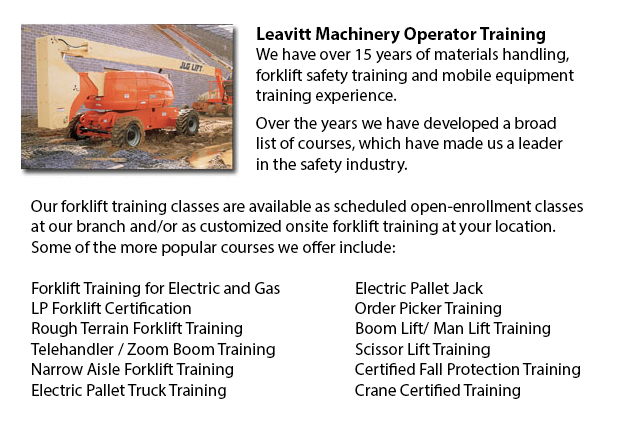
St Catharines Aerial Lift Safety Training - Each year, there are roughly 26 construction fatalities due to the use of aerial lifts. Most of the craftsmen killed are electrical workers, laborers, painters, ironworkers or carpenters. Nearly all deaths are caused by electrocutions, falls and tip-overs. The greatest risk is from boom-supported lifts, like for instance cherry pickers and bucket trucks. Most deaths are connected to this type of lift, with the rest involving scissor lifts. Other hazards include being struck by falling things, being thrown out of a bucket, and being caught between the guardrail or lift bucket and a thing, like a joist or steel beam.
The safe operation of an aerial lift needs a check on the following items before making use of the device: operating and emergency controls, personal fall protection gear, safety devices, and wheels and tires. Inspect for possible leaks in the air, fuel-system, hydraulic fluid. Inspect the device for missing or loose components.
The areas that worker would utilize the aerial device must be inspected thoroughly for potential dangers, like for instance holes, bumps, debris and drop-offs. Overhead powerlines need to be monitored and avoided. It is suggested that aerial lift devices be used on surfaces that are level and stable. Never work on steep slopes which go beyond slope restrictions specified by the manufacturer. Even on a slope which is level, wheel chocks, outriggers and brakes should be set.
Companies must provide their aerial lift operators with the right guidebooks. Operators and mechanics should be trained by a certified individual experienced with the applicable aerial lift model.
Aerial Lift Safety Guidelines:
o Before operating, close doors and lift platform chains.
o Do not climb on or lean over guardrails. Stand on the floor of the bucket or platform.
o Stay within manufacturer's load-capacity limits.
o Use work-zone warnings, like signs and cones, when working near traffic.
If correct procedures are followed, electrocutions are preventable. Stay at least 10 feet away from whatever power lines and licensed electricians must de-energize and/or insulate power lines. People working need to make use of personal protective equipment and tools, like for instance insulated bucket. Nonetheless, a bucket that is insulated does not protect from electrocution if, for example, the worker touches another wire providing a path to the ground.
When within the bucket, workers have to prevent possible falls by securing themselves to the guardrails by utilizing a full-body harness or a positioning device. If there is an anchorage inside the bucket, a positioning belt with a short lanyard is acceptable.
Tip-overs are preventable by following the manufacturer's instructions. Unless otherwise specified by the manufacturer, never drive whilst the lift platform is elevated. Follow the vertical and horizontal reach limitations of the device, and never go beyond the specified load-capacity.
-
St Catharines Heavy Equipment Training Schools
St Catharines Heavy Equipment Training Schools - When selecting an operator training course, there are a lot of heavy equipment training schools to choose from. To be able to ascertain the qualifications you will attain, it is very important to explo... More -
St Catharines Heavy Equipment Operator Training
St Catharines Heavy Equipment Operator Training - Heavy equipment operator training facilities that offer quality standards within the business, offering field performance work and additional machine training are really sought after training features... More -
St Catharines Forklift Training Programs
St Catharines Forklift Training Programs - Are you looking for work as a driver of a forklift? Our regulatory-compliant mobile equipment operator training offers instruction in kinds of forklifts, pre-shift check, fuel kinds and handling of fuels, an... More -
St Catharines Heavy Equipment License
St Catharines Heavy Equipment License - A heavy equipment license can be obtained by taking a certification and preparation course at a private training school or a vocational school. This license would qualify you to operate various types of heavy e... More -
St Catharines Overhead Crane Safety Training
St Catharines Overhead Crane Safety Training - Overhead crane safety training equips operators with skills and knowledge regarding crane safety precautions, accident avoidance, materials handling, and equipment and stock protection. Trainees will lea... More -
St Catharines Scissor Lift Training
St Catharines Scissor Lift Training - Scissor lifts should be operated proficiently to be able to protect the safety of the equipment and the wellbeing of others within the workplace. Operators who are skilled are trained to drive the specific type o... More -
St Catharines Telescopic Training
St Catharines Telescopic Training - Telescopic Handlers are a kind of forklift, normally known as telehandlers. This machine has been increasing in popularity due to its greater lift heights and its versatility. It is often preferred over the convent... More -
St Catharines Boom Lift Certification
St Catharines Boom Lift Certification - Utilizing elevated work platforms allow for maintenance operations and work to be carried out at elevated work heights which were otherwise unreachable. Boom Lift Certification Training educates workers about t... More

Forklift Certification St Catharines
TOLL FREE: 1-888-254-6157
St Catharines, Ontario
forkliftcertificationstcatharines.com/
Email Us
About Us


